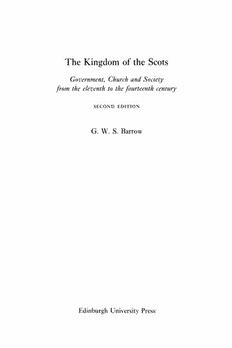
The Kingdom of the Scots: Government, Church and Society from the Eleventh to the Fourteenth Century PDF
384 Pages·2003·40.2 MB·English
Most books are stored in the elastic cloud where traffic is expensive. For this reason, we have a limit on daily download.
Preview The Kingdom of the Scots: Government, Church and Society from the Eleventh to the Fourteenth Century
Description:
This book explores the formative period when Scotland acquired the characteristics that enabled it to enter fully into the comity of medieval Christendom. These included a monarchy of a recognizably continental type, a feudal organisation of aristocratic landholding and military service, national boundaries, and a body of settled law and custom. By the end of the thirteenth century Scotland had a church based on territorial dioceses and parishes, centers of learning including monastic houses representing the main orders of western Europe, and thriving urban communities whose economic power counterbalanced the aristocracy's. How and to what effect these characteristics were acquired are the main subjects of the book. After the introduction, fifteen chapters are divided into three parts devoted to government, church and society. The volume comprises some of the most important as well as the most consistently readable work ever published on medieval Scotland. First published in 1973, it is now reissued in an updated edition with two new chapters. It also appears in paperback for the first time.
See more
The list of books you might like
Most books are stored in the elastic cloud where traffic is expensive. For this reason, we have a limit on daily download.
